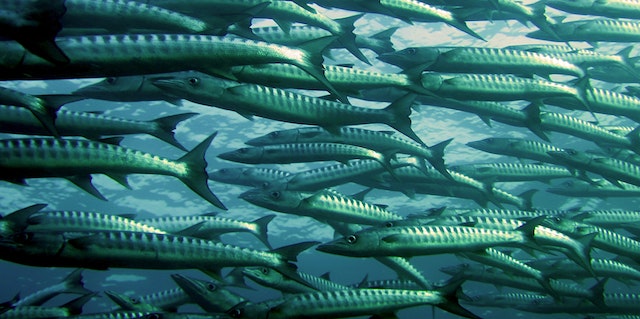
Why can fish swim so fast? They move their bodies from side to side in such a way that they produce a backwards moving wave in their bodies, which pushes against the water, producing thrust. Also, they are very streamlined.
First, we should clear up the fact that all fish are fast. There are some fish that use their fins to walk along the seabed and there are some fish that just float with the currents. Eels swim very slowly and they expend a lot of energy in the process. The Greenland shark only swims at about 1.2 km/h, which is one of the reasons why it lives so long. We can swim faster than the Greenland shark. The average human can swim at about 3 km/h, twice as fast. Michael Phelps, the Olympian with the most gold medals, has reached a speed of 7.6 km/h. That may be faster than the fish I have mentioned, but the majority of fish can swim far faster than this.
Some fish, such as the marlin and the swordfish can reach speeds of 120 km/h. They can’t sustain it for very long and they only really use it to escape prey, but they can move very quickly. The fastest submarine we have can only travel at 82 km/h. Many other fish have high top speeds as well. Even their cruising speeds are far faster than any human can swim. So, why can fish swim so fast?
One of the reasons is their shape. We have not evolved to swim. Olympic swimmers have to do as much as they can to streamline themselves because we have a lot of sticking out bits that slow us down. Fish have evolved to be very streamlined. Their shape is perfect for moving through a liquid. They have a pointed nose that forces the water to part with as little pressure as possible. Then, their scales all point towards the back of the fish and are made of a smooth material to reduce resistance as much as possible. Their fins as narrow and angled to cut through the water. Some fish, such as tuna, have many small fins at the back of their body which channel the water passing the fish along the body, cutting down on the drag.
The main reason fish are fast comes down to the way they swim. Fish don’t swim by just moving their tails from side to side or by using their fins. They swim with their whole bodies. The fins are used to steer, and the tail is used to start the motion of the body. They have strong muscles along their sides, and they contract and relax these muscles in order to curve their bodies like a wave. Water doesn’t compress and each time the fish contracts the muscles on one side and curves, it pushes against the water, creating thrust. Fish do this so quickly that they are able to push themselves through the sea at great speeds. They are helped by tendons that connect their vertebra and give them a lot of elastic energy. Tendons are springy and they can store energy, using it to return to their original shape. This is better than a muscle in some circumstances because they do it with a lot of elasticity and they don’t require any energy from the body in the way that muscles need to move. The tendons aid the muscles in the fish and help them swim faster. Then, once they are moving, their shape helps them cut down on drag and keep moving.
Incidentally, all fish have tails that are vertical and all mammals that swim, such as whales and dolphins, have tails that are horizontal. This is to do with the way they have evolved. Fish have evolved from a creature called a Pikaia, which is like a tiny snake. It moved by zig-zagging its body in the same way that snakes do now and moved along the bottom of the sea finding food. Fish have inherited this sideways movement and their tails are vertical. Whales and dophins evolved from four-legged land animals that moved into the sea. Their legs became fins and flippers, and their tails are horizontal because they have spines that evolved to move up and down to make their legs move when they run, in the same way as a horse or a cheetah. And this is what I learned today.
Photo by Peter Simmons: https://www.pexels.com/photo/gray-and-silver-school-of-fish-underwater-photography-66218/
Sources
https://www.technologyreview.com/2018/12/18/138543/we-finally-know-how-fish-swim-so-fast/
https://a-z-animals.com/blog/the-10-fastest-fish-in-the-ocean/
https://www.wonderopolis.org/wonder/who-is-the-fastest-swimmer
